I started out by studying astrophysics at University College London. Part of the reason I did that is I quite liked that idea of looking at systems at the boundary conditions, i.e. when you're pushing them to their limits.
In astrophysics, it was the physics of the oldest, the coldest, the heaviest, the hottest, the brightest and so forth, and using this as a tool to try to reveal properties of the system that otherwise remain hidden.
I really enjoyed my astrophysics degree, however, when I finished I thought I should do something a bit more practical, and so I went on to apply for and study medicine. At that point I thought, ‘I'll never have anything to do with astrophysics ever again’.
However, after I graduated, I rekindled that interest in the science of the extreme, and, in this case, not the physics of the extreme, but the physiology of the extreme. That same theme cropped up for me again, but this time in medicine, and so, here I was trying to think about looking at the body as you pushed it to its very limits to try and understand the properties of that system more completely.
So, for me, extreme medicine and extreme physiology is all about looking at the body as a system and how it is challenged by the extremes of physical environment or critical illness, and through that endeavor, trying to understand and then learn how to best intervene.
How much is currently known about the impact long duration spaceflight has on the body and how has our understanding changed over time?
The understanding of how long-duration space flight affects the human body has come on quite considerably in recent years, and in large part, we owe that to programs of research that have taken place aboard the International Space Station and the Mir Space Station.
Now, we have quite large numbers of astronauts who have flown for many weeks, if not months, at a time, and scientists back on the ground have had a chance to look at them, and look at what happens to their bodies.
That said, when I say quite large numbers, in absolute terms, it's pretty tiny. The total number of people who have ever flown in space is around about 500 ever, ever in the history of our species. So, everything that we know about the effect of space flight on the human body is drawn from that experience of less than 1,000 people.
Whilst compared to 1961, when Yuri Gagarin first flew in space, we have a much more mature understanding of what happens to the human body in that completely alien environment, we've still got a long way to go.
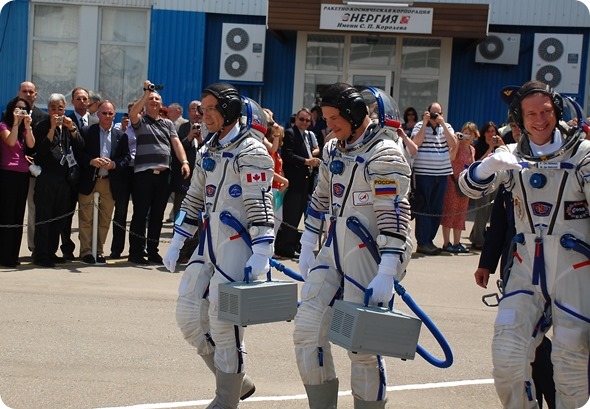
Soyuz spacecraft crew (R.Thirsk, R.Romanenko, F.DeWinne) ready for their flight to ISS May 27, 2009 in Baikonur cosmodrome, Kazakhstan. Image credit: vicspacewalker / Shutterstock.com
Why does the body experience wasting of the bones and muscles when in outer space? Does this put a limit on how long one could spend in space?
We take gravity for granted on earth because we cope with it, we swim in this field of gravity, and so, you're never really fully aware of how much it shapes you and the functions of the organs of your body.
Gravity sculpts pretty much every system in one way or another, and for the bones and the muscles, it's very obvious why that happens. One of the primary functions of muscle and bones as systems is to bear loads against the force of gravity, and they remodel themselves according to the stress or strain that's placed on that system.
That's the theory of bodybuilding. If you want to build bigger muscles, you lift progressively heavier weights and more frequently. If you want to increase your peak bone density, then you play a lot of high-impact, load-bearing sports in your youth and your teenage years.
So, gravity sculpts those systems in that way, but then, when you remove gravity, the body responds in what's essentially an appropriate way. It says, well, why should I carry around all of this excess mass to do a job that doesn't need to be done anymore, the job of load-bearing? So, it gets rid of muscle very quickly, and it gets rid of bone fairly quickly.
The wasting of muscle and bone in space happens rapidly, and it's appropriate for that environment, it's appropriate for weightlessness. Your body is very clever. Having evolved over billions of years in an unchanging 1G environment, when deployed in space, it knows what to do, it tells the body to shed the muscles and bones.
Over what time period does this occur?
Experiments with animal models have shown wasting of the quadriceps muscle (the thigh muscles): more than a third of the mass can go in the first seven to ten days, so in about a week, you're losing about a third of that mass.
It's not just quantity, you also lose quality. There are two principal types of muscle fiber, the slow twitch and fast twitch, and the fast twitch is what carries a 100 meter sprinter down the track, and the slow twitch is the stuff that the marathon runners use that's got a very high endurance. The latter has less in the way of force, but it's that muscle that you need for the endurance activities.
Over time in space you lose the endurance muscle, the slow twitch muscle, in favor of the fast twitch muscle, and that is also a problem. By virtue of going up to space, you basically end up becoming a couch potato by default.
A lot of the astronauts are, if not professional athletes, very athletic in their own right. You take these people who are highly trained at a very high level of physical fitness, and you force them to become couch potatoes for six months of a year at a time.
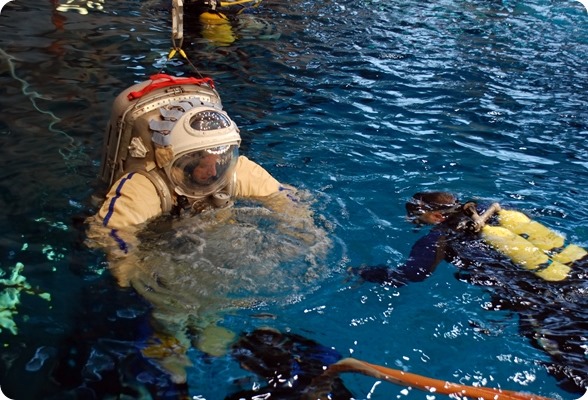
US astronaut J.Williams is taken into water for spacewalk training at Russian Hydrolab water immersion facility Feb 20, 2009 in Star City, Russia. SCUBA divers assists. Image credit: vicspacewalker / Shutterstock.com
What hurdles do we face in the future exploration of space?
The major hurdle now is distance, because what we've done over the last half century is learn how to live and then work in space in low-earth orbit. That's been a tremendous effort. It's been hard just to get that distance into space, hard just to reach 250 nautical miles or so, which is where low earth orbit lies, and understand how to do that without dying on the way there, without dying once you get there, and to continue to be able to function and work for many, many weeks and then months at a time.
Now that we've done all of that, the next thing, I think, is for us to extend our reach, both in terms of distance and in terms of time, because that's what we need to do to get to the next most interesting destinations that are out there.
You can take your pick, and people have debates about where the next destination for human space flight should be. So, Mars, or a near earth object, such as an asteroid passing relatively close by to the earth, or the moon, but in all of those cases, you're going to be taking on missions that are much longer than anything that we've flown before, and much further from the earth than anything we've flown before.
So, we need to increase the self-reliance of the crew, their ability to cope on their own without any help or any means of escape from their situation, but we also need to increase their resilience, in terms of the medicine.
We need to protect them to make sure that, as far as possible, you can keep them healthy and not have them get sick. You also need to try and think through the possible scenarios of what happens if something does go wrong and they become injured or they become ill. What are you going to do?
It's a very different scenario from them being on the International Space Station. On the International Space Station, if things go wrong, you can be home in a matter of hours. On your way to Mars, you might be up to two years away from home, maybe more.
Your recent book Extreme Medicine discusses Robert Falcon Scott's 1912 expedition to the South Pole. What impact does extreme cold have on the body?
When you look at the physical extremes over the last 100 years, you have to recognize that we hadn't really conquered all of the physical extremes of the earth until relatively recently. We needed technology and engineering to protect us from those locations.
Just over a century ago we hadn't gone to the South Pole, we hadn't gone to the summit of Mount Everest; we hadn't dived the ocean trenches, let alone go into the endless skies with aircraft, and forget about space. So, we hadn't really probed those extremes of cold, or tried to survive them in the way that Scott and his team did.
We are essentially tropical animals - that's the environment in which we evolved - equatorial animals that really never want to stray very far from that sort of climate and a source of water. Yet, with Scott's expedition, you find them going to the highest, most arid, coldest place on the earth, and trying to do so with very limited protection from that.
When their protection from that fails, when they fail to get out of the way of a coming Antarctic storm, they hold on as hard as they can for as long as they can, but eventually they succumb, and once you start to succumb to the cold, you're onto a losing battle.
The reason that you freeze to death is that, effectively, your body, which is set to work at a very narrow range of temperatures - 37 degrees, plus or minus 0.2 degrees is where it's supposed to work - once you start to lose the ability to control your own temperature, then the whole system starts to break down.
At the molecular level, you have molecular pumps within your body which pump ions across the membranes of the cells of your body. These pumps are responsible for creating the motive force that is life itself. These things eventually start to break down, and so, essentially, the batteries within your cells, the stuff that provides the source of power that is life itself, and the thing that facilitates complex life, effectively begins to run down, and when that happens, death isn't very far away.
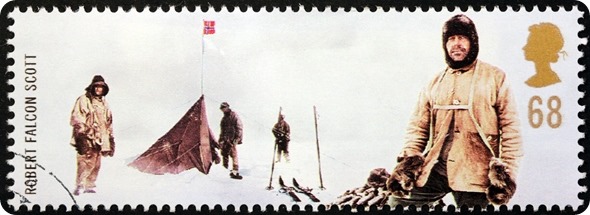
A stamp printed by UNITED KINGDOM shows Royal Navy officer and explorer Robert Falcon Scott who led two expeditions to the Antarctic, circa 2003. Image credit: Sergey Goryachev / Shutterstock.com
How has our understanding of hypothermia developed since 1912?
We didn't learn directly from Scott about how to use hypothermia in medicine, but what we learned from Scott was that there were ways to protect ourselves from those extremes, physical extremes.
Not much later into the century, we started to look at hypothermia as a way of preserving people when their hearts had stopped, and preserving their brains for longer periods, so that the oxygen starvation didn't damage the brain. This was in the early days of cardiac surgery.
It was understood that, in some surgeries, the surgery is so complex that you couldn't operate on the beating heart. Whilst you could find ways to stop the heart, you didn't want to do this for very long because the brain would become damaged within just a few minutes.
So, a technique was developed to cool the body down to much lower than its core temperature - to about half of its core temperature, around 18 to 20 degrees Celsius. Once you had done this you could stop the heart be injecting a solution and then keep the heart at a standstill for a much longer period of time - more than half an hour. This gives the surgeon more time to operate, and protects the brain from the consequences of oxygen starvation at the same time.
The theory, at the time, was that what you were doing was simply slowing down the metabolic rate. It was that simple chemical principle that, if you slow down the temperature of a system under chemical reaction, the chemical reactions themselves slow down.
To a degree, that's true, but there are other protective effects of that act that also assist you. That's what we learned to do later on, and if you go forward from Scott through the 20th century, you see any number of endeavors in exploration but also in medicine that are of this willingness to push the boundaries of human survival and endurance in different ways, and so, the relationship between Scott and the early days of cardiac surgery is that exploratory sense of pushing the boundaries of human endurance.
For Scott, it was in the name exploration, but for the people who were around at the early days of cardiac surgery in the late 1940s and early '50s, it was all about looking for a new surgical paradigm, one in which you could perform complex surgery on the heart while it was at a standstill.
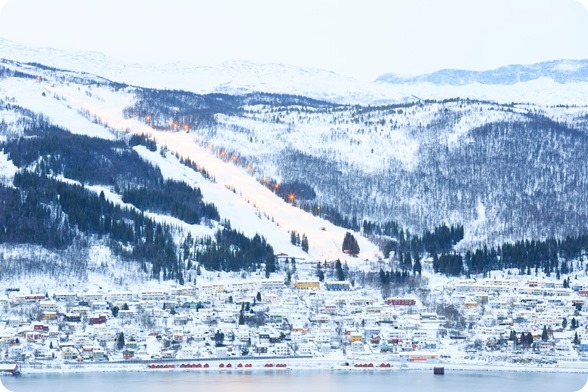
Narvik Cityscape. Image credit: vichie81 / Shutterstock.com
Has your research altered your views on the boundary between life and death?
I think when I was writing the book, I just wanted to get a sense of just how far we've come in the last 100 years.
As a doctor of medicine, I always understood that the line between life and death was a very gray thing. It's not black and white, and death is not an event but a process. That's what you come to understand if you work in any part of medicine, but particularly in anesthesia in intensive care as I do.
So, I was always aware that the line dividing life from death, the line between survival and non-survival is very, very blurred, but I don't think they're really appreciated just how blurred.
In the course of researching the book, I ran into Anna Bagenholm, who's the girl whose story I tell in the first chapter. This girl froze to death in the Arctic Circle in a skiing accident, but then was resuscitated successfully three hours after her heart had stopped.
I don't think I'd really fully appreciated just how much you could smear that line out and play with it, and how profoundly you can disturb human physiology and then rescue it again.
Anna's story, is one that almost all doctors know, it's this story that does the rounds in whispers in almost legendary terms, so much so that you think it must be exaggerated. But when you talk to her and you read the hard detail of the case, you suddenly realize how unbelievable that is, how gobsmacking that is as a feat of survival, a feat of modern survival, and a chance of survival that probably didn't exist, or had never before existed, until her accident.
Her survival is a happy accident created by any number of innovations over the 20th century that have come about through exploration, and medicine, and research, and serendipitous discovery. For me, that's what I most took away from the writing of the book, it was just how much our progress of the 20th century was a feat of exploration. None of it was intended.
Anna Bagenholm's survival is not a deliberate thing. It happens because of the feats of exploration, true exploration and medical exploration that occurred in the preceding ten decades.
More and more, I think, beyond anything else, it wasn't my sense of the limits of the human body and life and death that changed, but, actually, my sense of how medicine advances really changed. It felt, after a while, much less like this plodding, inductive, step-by-step, incremental improvement, and began to feel much more like this feat of bold exploration, and I just saw a much harder parallel between the sorts of people who used to run around the world trying to come upon a new territory, and the people who pioneered new techniques in the 20th century in medicine.
What impact do you think exploration will have on medicine going forwards?
I think that we draw this false dichotomy between feats of exploration and medicine. We draw, actually, some sort of division between medicine and other areas of science and in fact, I think, at the end of the day, they are all prosecuted in the same way. They are all this head-long charge into the unknown in the hopes that survival and good fortune lie in wait.
We put the narratives together retrospectively to make it sound all like it was all intended, and it was all there by careful design, but when you really look at these stories up close, in every story you look at in the book, it is that sense of exploration in every major breakthrough, and it is that sense of exploration that runs through it. It's the constant through all of that, and I think that's to be celebrated.
Where can readers find more information?
More information can be found in my book: Extreme Medicine: How Exploration Transformed Medicine in the Twentieth Century
About Dr Kevin Fong
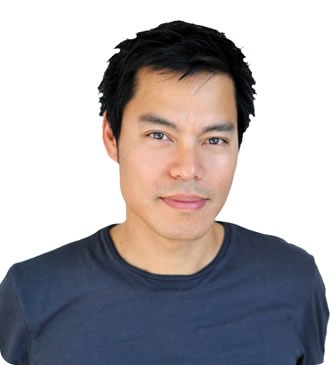 Kevin Fong holds degrees in medicine, astrophysics, and engineering and is an honorary senior lecturer in physiology at University College London. He has completed specialist training in anesthesia and intensive care medicine, has worked with NASA, and is the founder of the Centre for Altitude, Space, and Extreme Environment Medicine.
Kevin Fong holds degrees in medicine, astrophysics, and engineering and is an honorary senior lecturer in physiology at University College London. He has completed specialist training in anesthesia and intensive care medicine, has worked with NASA, and is the founder of the Centre for Altitude, Space, and Extreme Environment Medicine.
Fong has created and starred in several documentaries for the BBC and Radio 4 in the UK. He writes for The Guardian, has a regular column in The Times (UK) Higher Educational magazine, and is the author of Extreme Medicine: How Exploration Transformed Medicine in the Twentieth Century.